Your cart is empty now.
The Sri Chakra which is the representation of the Sri Vidya is the means by which the Goddess is propiated and worshipped. This book which explains the symbolism behind the Sri Chakra and the textual background for this Tantric cult.
Vidyalankara, Sastra-Chudamini, Sangita-Kalaratna, Professor Saligrama Krishna Pamachandra Rao, was a well-known scholar who had combined traditional learning with modern research. Well versed in Sanskrit, Pali, Ardhmagadhi and several modern Indian languages and acquainted with Tibetan and some European languages, he had written extensively on Vedanta, Buddhism, Jainism, Indian Culture, Art and Literature. He had written more than Sixty Books in Kannada, a Play in Sanskrit, and a Pali Commentary on a Buddhist classic. One of his books on Iconography in Kannada has won the State Sahitya Academy Award, as also another of his Book on the Tirupati Temple. Some of the books he had authored are Bhavanopanishad, The Tantra of Sri Chakra, Sri Vidya Kosha, Vishnu Kosha, Sri Suktam, Vastu silpa Kosha (3 Vols), The Tantric Practices in Sri Vidya; Tantra, Mantra, Yantra: The Tantra Psychology and Sri Chakra: It's Tantra, Mantra and Yantra.
The Sanskrit expression 'chakra' usually means a 'wheel'. The etymology of the word would suggest 'that by which any thing is done' (kriyate anena). The wheel of the cart, the wheel of the potter, the wheel-like weapon that is flung against the enemy are all called 'chakras'. In its extended meaning, chakra also signifies a kingdom, and because the wheels of the King's chariot can roll on there without hindrance, The King of the land is thus described as a 'chakra-vartin'. The word also signifies an arrangement of the army (chakra- vyuha), in order to fortify its position and secure victory. Sanskrit poets are found to employ characteristica Ily circular patterns of letters of words (chakra-bandha), to convey the meaning more forcefully (if also more tortuously) than usual.
Whatever the sense in which the word is employed, it invariably means a power-field, an arrangement of parts 60 as to accomplish the desired end. The circular form which the chakra usually brings to mind denotes both comprehension and facility. It comprehends all the parts, units and details in a. compact and effective manner, 60 that the whole form is unitary and functional.
But the form need not necessarily be circular. The idea of comprehension may be metaphorical t as in expressions like rtu-chakra ('the round of the seasons'), rasi-chakra ('the pat- tern of the zodiac') , nakshatra-chakra ('the collection of stars') and nadi-chakra ('the arrangement of arteries').
The psychophysiological constructs of normal human energy in terms of the six 'chakraa' (muladhara at the base, svadhish- thana at the root of the penis, manipura near the navel, anahata in the heart, visuddha behind the throat, ajna bet- ween the eye-brows) answer to the same description. Each of these chakras is a conceptual categorization of a pattern of energies, proper to that level of organisation, The chakras do not suggest anatomical parts, nor even, physiological functions. They are entirely abstractions even as the sahasrara ('the thousand-petalled lotus', which is in actuality outside the psychophysical framework, and hence called niralaniba-puri) imagined to be on top of the head, the manas-chakra ('the mind centre', responsible for the experiences of dream, hallucination etc.), and the soma-chakra (the moon-centre', responsible for compassion, dispassion, generosity, patience etc.) are. They are individual vorteces of energy dynamics.
The imagery of chakra as a potent pattern of forces involving cohesion, regularity and functional unity is an old one in India. Its visual representation is to be found even in the remains of the Indus valley civilization, and its verbal expression is to be found even in the hymns included in Rgveda -, Since those early days, it is a recurrent imagery employed in diverse contexts: as samsara-chakra ('the trans-migratory round of phenomenal occurrences'), kala-chakra ('the generative cycle of time') , dhartna-chakra (the "wheel of the doctrine') , yogini-chakra ('the representation of recurrent female divinities') , mantra-chakra (the cycle of sacred formulae') and so on. It is interesting to note that in extreme tantrik practices which are also antinomian in character, the mystic sessions of spiritual orgies were called chakras (viz., the aggregation of participants who are united under a common cultic discipline), and the deliberation in such sessions was called chakra-puja, a term of dubious reputation.The idea of an effective aggregation of abstract deities, concretely represented by initiated human participants, in a mystically potent session was basic to this tantrik context. The concept of bhairavi-chakra where drink and debauchery are subliminated to their spiritual counterparts is well-known in occult literature. The same idea is relevant in the concept of rasa-mandala, a particular pattern of the male and female devotees of Krshna, identifying themselves with Krshna and the cowherd damsels (gopis). engaged in dance-rituals involving amorous details.
Incidentally, the expression mandala is generally synonymous with chakra. This word also means a wheel, something circular, a unitary aggregation of details, a kingdom, an army. We have words like dharani-mandala or bhu-mandala ('the earth circle'), surya-mandala ('the solar orh'] , chandra-mandala ('the lunar orb'), nara-mandala ('the aggregation of arteries'), nabhi-mandala ('the pattern of energies at the navel center');and tara-mandala ('the group of stars'). This word acquired an especial cultie significance in the tantras belonging to the Mahayana Buddhist persuation and to the Natha-siddha ideology. 'Mandala-offering' and 'mandala-visualization' are important details in the religious practices of Tibet, Mongolia and Japan. And there are treatises dealing with Mandala-worship and explaining its symbolism written by Natha-siddhas, Buddhist tantrik masters and Tibetan yogis.
Mandala in this context is defined as 'that which gathers the essential details' (mandam lati). A popular tantrik text, Tantra-raja-tanra describes the nature and uses of mandala in worship and in meditation. Like, chakra, mandala denotes an act of concentration of all the significant details of the world, or of a doctrine, of ones own constitution or of his own mind. It. is also the place where such concentration is facilitated. As an act of concentration, it gathers up the inner energies, and as a place for concentration, it brings together the outer energies. It is an expedient or device that has been tried out, confirmed and standardized.
It is also called a yantra, which is usually described as a concrete, mostly visual, representation of the act of concentration of the devotee's own thoughts as well as the place of concentration of the forces in the outside world. It is more often looked upon 8S a gadget, a contraption, a mechanical device. The three words, chakra, mandala and yantra, are in Fact synonymous. But in popular imagination, each connotes a characteristic feature that distinguishes it from others. For instance, chakra suggests a circular form, while the mandala may be a figure of any shape (usually a square). While both chakra and mandala are usually linear representations (some- times brilliantly coloured, especially mandala), yantra is a three-dimensional model. It must be noted that there is also a three-dimensional model of Sri-chakra (called meru), and that there are physical models of mandalas in various materials in Tibet and Japan (especially for offering). And not infrequently Sri-chakra is also called Sri-yantra.
Whether it is called a chakra, mandala or a yantra, the instrument is a sphere of influence, a consecrated ground, an arena for the play of thoughts, feelings and forces both inside the devotee and outside him. It is an instrument that is employed to activate energies, stimulate thoughts, harmonize feelings, and co-ordinate inner and outer forces, It is rightly described as a psychocosmogram.
As an instrument mediating between the aspects of energy inside the individual and the dimensions of energy out-side him, it is structured functionally into three levels of 'space' as a medium of movement: the level constituting the physicalworld of things and beings (mahakasa), the level representing thoughts and feeling8 (chittakasa), and the level of pure, undifferentiated consciousness (chidakasa). The first represents the objective world, the second the subjective appraisal thereof, and the third the elimination of this duality. Space, by definition, is luminous (from the root kas, 'to shine'), The, three levels denote three degrees of the luminosity. The first Jevelis where the naturally luminous space is almost wholly clouded by the predominantly inert and inhibiting tamas. In-the second level, however, the' luminosity is partially permitted by the influence of the active 'and emotional rajas; The luminosity is maximized in the third level, for it is the light of pure awareness, sattua, that dominates there.
The chakra, therefore, enables the transformation of the fist level of space into the second, and the second into the third, In a crude manner of speaking, we may describe it as the conversion of matter into energy, and energy into consciousness. As the transformation takes place, greater harmony is achieved. The distinction between the objective world, the subjective person and the consciousness that is at once both objective and subjective and neither objective nor subjective, breaks down.
The complete harmony of existence is symbolized by the point (bindu) that occupies the central position in a chakra, In fact, the chakra is described as an unfoldment ( srshti) of the bindu, and the bindu as the enfoldment (samhrti) of the chakra. The imagery of the all-enveloping space issuing out of the womb of a dimensionless (and therefore imperceptible) point is frequently met with in tantric texts. The body is the space, and pure consciousness is the point. Thus there is twofold movement in practices connected with chakra: from the formless bindu to the form of the chakra, and from the concrete representation of the chakra to the abstract bindu Chakra is a device or instrument that facilitates both these movements.
| I | Introduction | |
| 1 | Atharva-veda | 1 |
| 2 | Upanishadic Framework | 5 |
| 3 | Bhavanopanishat | 11 |
| 4 | The Meaning of Bhavana | 16 |
| II | The Text | 28 |
Sample Pages
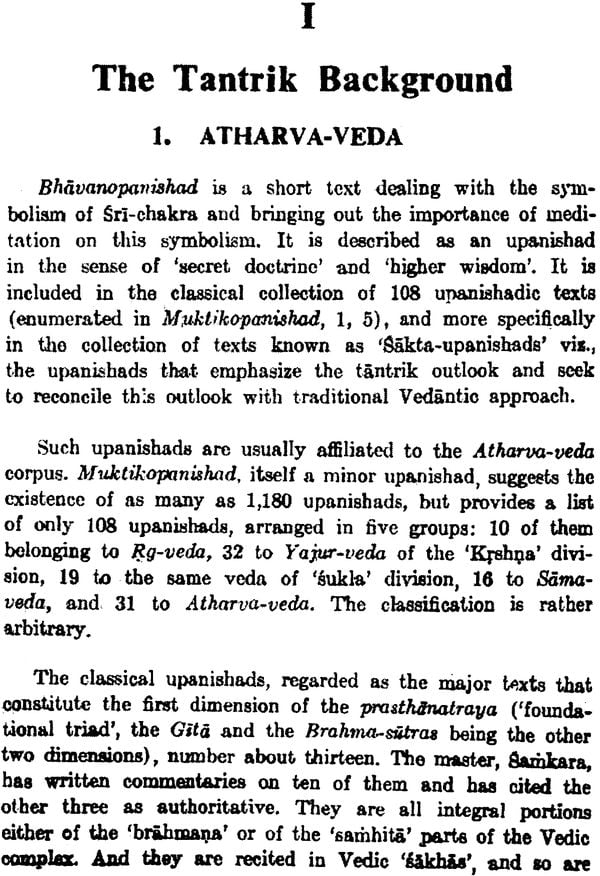
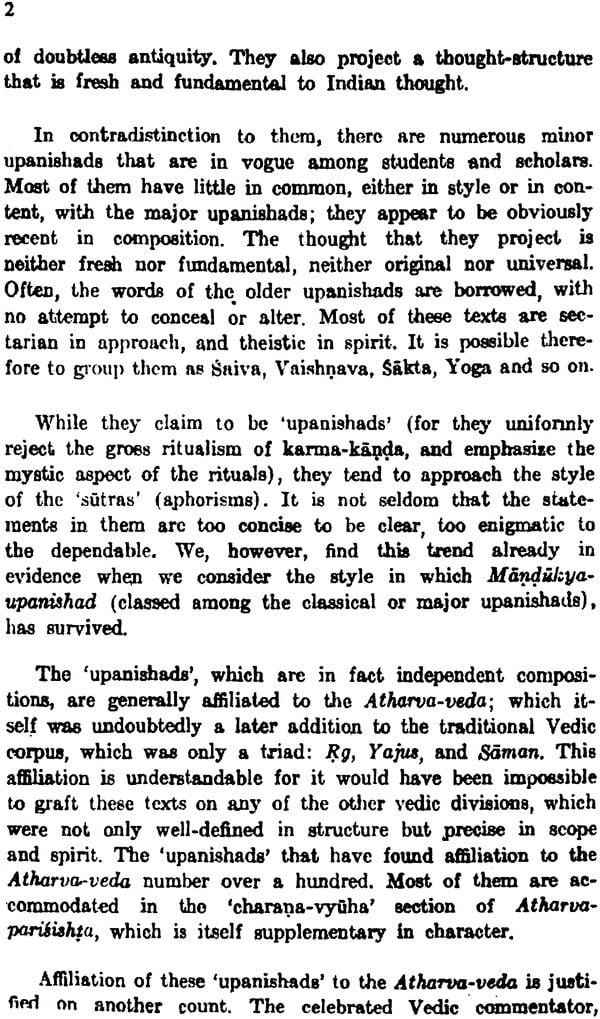

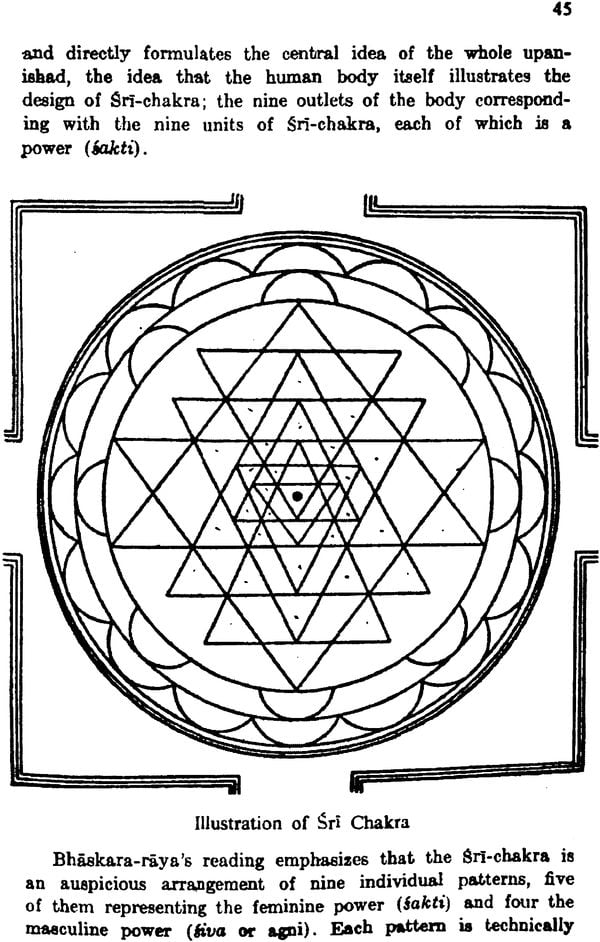
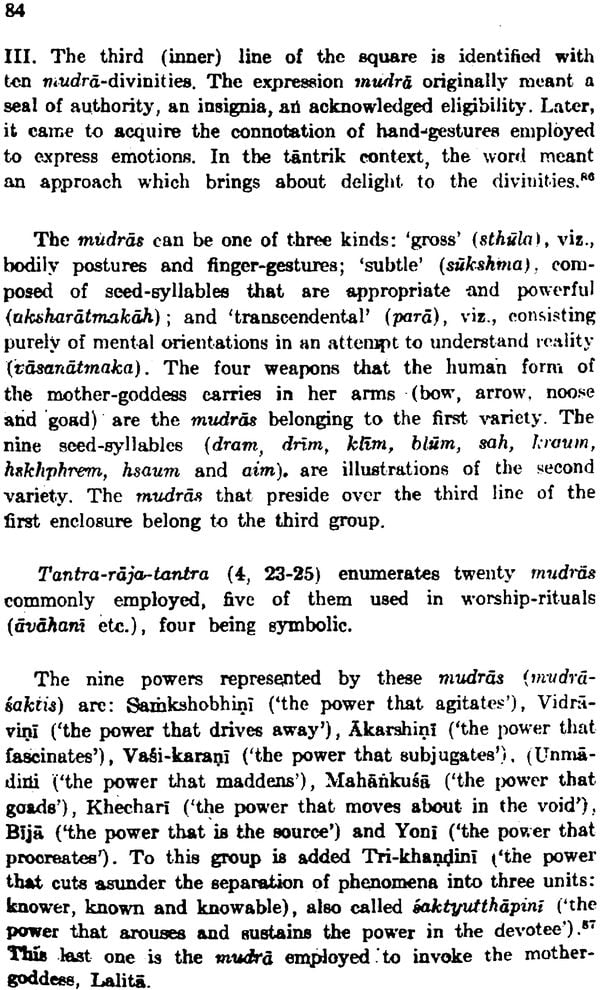
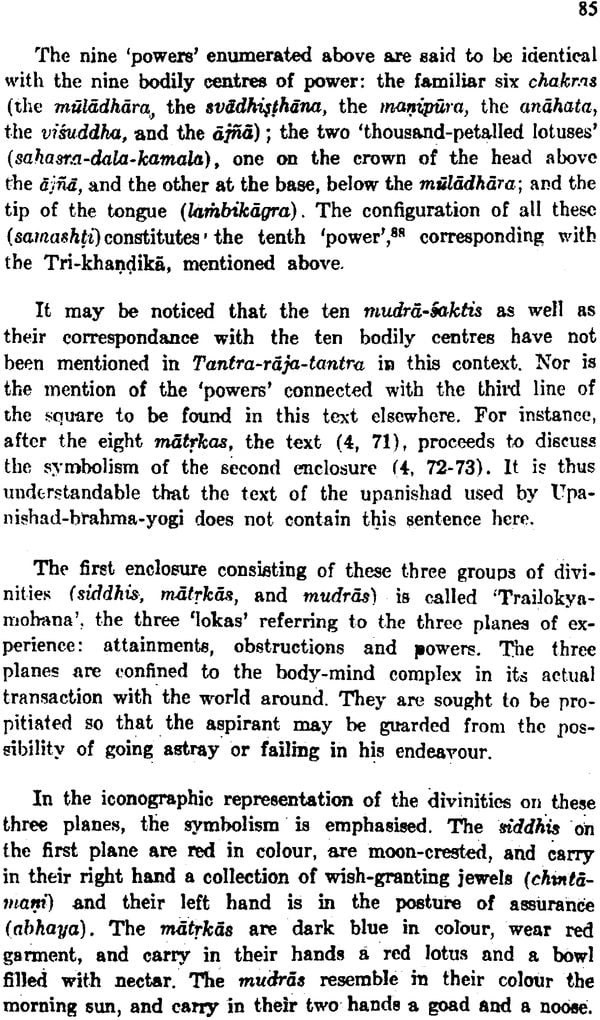
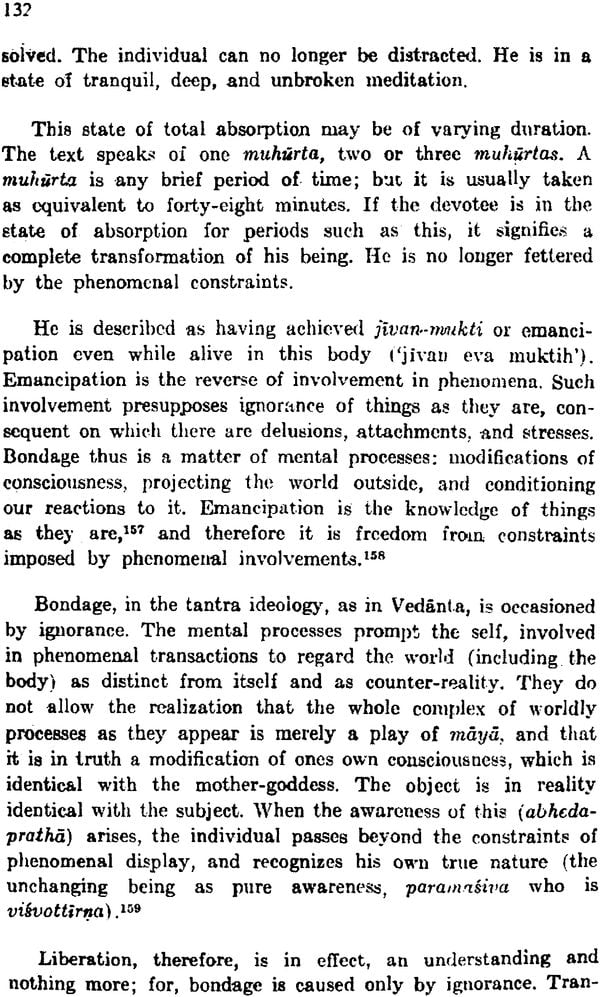
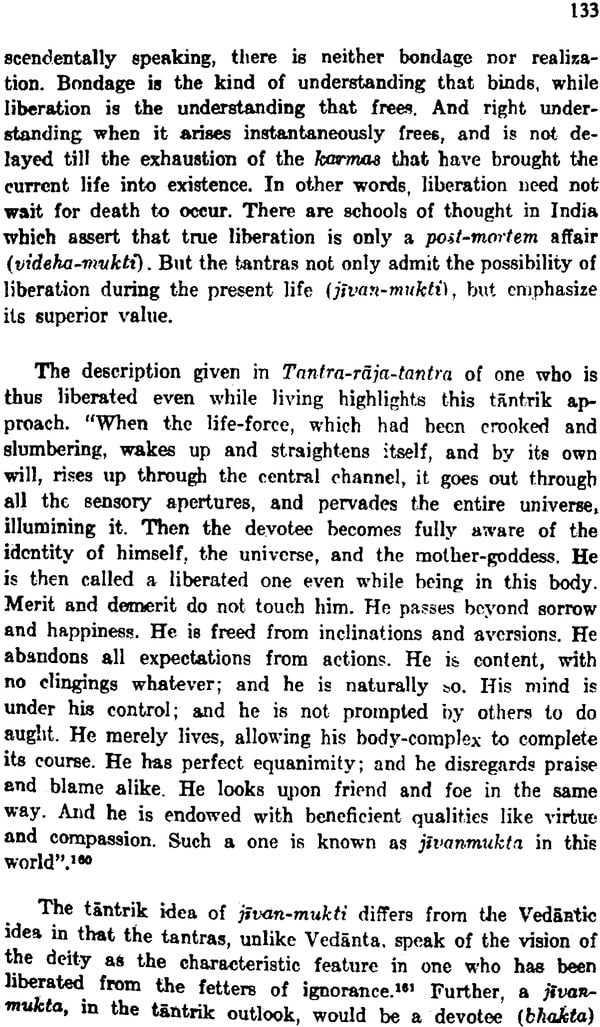
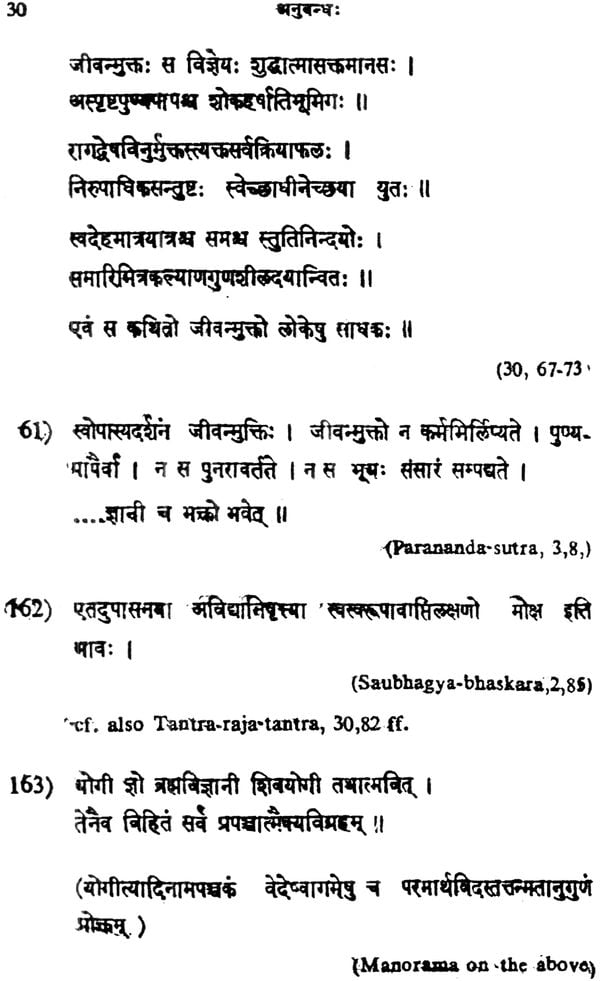
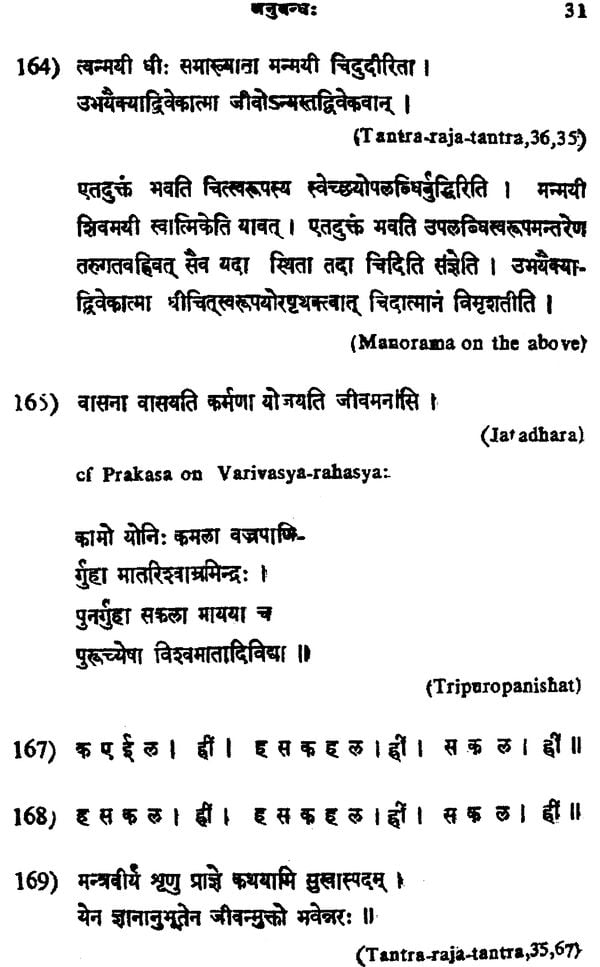
Delivery and Shipping Policy
- INTERNATIONAL SHIPPING
- Rs.1000-1100/kg
- ESTD. Delivery Time: 2-3 weeks (depending on location)
- Bubble Wrapped with Extra Padding
- NATIONAL SHIPPING
- NCR: Rs. 30/half kg
- Standard: Rs. 80/half kg
- Express shipments also available on Request
- ESTD. Delivery Time: Ranging from 1-4 days up to 7 business days (Depending on your choice of Delivery)
- TRACKING
- All orders; national or international, will be provided with a Tracking ID to check the status of their respective orders
- Depending on the Shipping Service, Tracking ID may be used on their respective tracking portals
Frequently Asked Questions (FAQs)
Domestic Shipping: 3-4 Days (after shipping)
International Shipping: 1-2 weeks (based on your location)
You will receive an email once your order has been shipped or you can email us if you didn't receive tracking details (info@mlbd.co.in)
Every book that we sell is the latest edition except all the rare books
Yes, we do provide free shipping, only on domestic orders (within India) above Rs.1500











